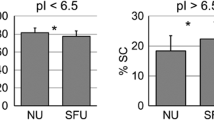Abstract
Tamm-Horsfall glycoproteins (THPs) from healthy probands and a majority of recurrent calcium oxalate renal stone formers reveal different physicochemical properties when analyzed using isoelectric focusing (IEF). The pI values of THPs from healthy probands are approximately 3.5 while THPs from recurrent renal stone formers have pI values of between 4.5 and 6. The two groups of THPs exhibit completely different protein patterns. The differences in IEF analysis allow differentiation between THPs from healthy probands and recurrent calcium oxalate stone formers and may possibly be used as a simple diagnostic method for the recognition of recurrent calcium oxalate renal stone formers.
Similar content being viewed by others
References
Boevé ER, Cao LC, de Bruijn WC, Robertson WG, Romijn JC, Schröder FH (1994) Zeta potential distribution on calcium oxalate crystal and Tamm-Horsfall protein surface analyzed with Doppler electrophoretic light scattering. J Urol 152:531
Boyce WH, King JS, Jr. (1963) Present concepts concerning the origin of matrix and stones. Ann Rev NY Acad Sci 104:563
Coe FL, Parks JH (1988) Physical chemistry of calcium stone disease. In: Coe FL, Parks JH (eds) Nephrolithiasis: pathogenesis and treatment. 2nd edn. Year Book Medical, Chicago, p 38
Coe FL, Nakagawa Y, Parks JH (1991) Inhibitors within the nephron. Am J Kidney Dis 17:407
Coe FL, Parks JH, Asplin JR (1992) The pathogenesis and treatment of kidney stones. N Engl J Med 16:1141
Edyvane KA, Hibberd CM, Harnett RM, Marshall VR, Ryall RL (1987) Macromolecules inhibit calcium oxalate crystal growth and aggregation in whole human urine. Clin Chim Acta 167:329
Gelsema WJ, de Ligny CL, van der Veen NG (1979) Isoelectric points of proteins, determined by isoelectric focusing in the presence of urea and ethanol. J Chromatogr 171:171
Goldwasser B, Weinerth JL, Carson CC (1986) Calcium stone disease: a overview. J Urol 135:1
Görg A, Postel W, Westermeier R (1978) Ultrathin-layer isoelectric focusing in polyacrylamide gels on cellophane. Anal Biochem 89:60
Hagberg BA, Blennow G, Kristiansson B, Stibler H (1993) Carbohydrate-deficient glycoprotein syndromes: peculiar group of new disorders. Pediatr Neurol 9:255
Hård K, van Zadelhoff G, Moonen P, Kammerling JP, Vliegenthart JFG (1992) The Asn-linked carbohydrate chains of human Tamm-Horsfall glycoprotein of one male. Eur J Biochem 209:895
Hess B, Nakagawa Y, Coe FL (1989) Inhibition of calcium oxalate monohydrate crystal aggregation by urine proteins. Am J Physiol 257:F99
Hess B, Zipperle L, Jäger P (1993) Citrate and calcium effects on Tamm-Horsfall glycoprotein as a modifier of calcium oxalate crystal aggregation. Am J Physiol 265:F784
Jaeken J, Carchon H (1993) The carbohydrate-deficient glycoprotein syndromes: an overview. J Inherit Metab Dis 16:813
Knörle R, Schnierle P, Koch A, Buchholz NP, Hering F, Seiler H, Ackermann T, Rutishauser G (1994) Tamm-Horsfall glycoprotein: role in inhibition and promotion of renal calcium oxalate stone formation studied with Fourier-transform infrared spectroscopy. Clin Chem 40:1739
Kumar S, Jasani B, Hunt JS, Moffat B, Asscher AW (1985) A system for accurate immunolocalization of Tamm-Horsfall protein in renal biopsies. Histochem J 17:1251
Rambausek M, Dulawa J, Jann K, Ritz E (1988) Tamm-Horsfall glycoprotein in diabetes mellitus: abnormal chemical composition and colloid stability. Eur J Clin Invest 18:237
Robertson WG, Scurr DS (1986) Modifiers of calcium oxalate growth found in urine. II. Studies on their mode of action in an artificial urine. J Urol 136:128
Robertson WG, Peacock M, Marshall RW, Marshall DH, Nordin BEL (1976) Saturation-inhibition index as a measure of the risk of calcium oxalate stone formation in the urinary tract. N Engl J Med 294:249
Ryall RL, Harnett RM, marshall VR (1981) The effect of urine, pyrophosphate, citrate, magnesium and glycosaminoglycans on the growth and aggregation of calcium oxalate crystals in vitro. Clin Chim Acta 112:349
Schnierle P, Sialm F, Seiler H, Hering F, Rutishauser G (1992) Investigations on macromolecular precipitation inhibitors of calcium oxalate. Urol Res 20:7
Tamm I, Horsfall FL (1950) Characterization and separation of an inhibitor of viral hemagglutination present in urine. Proc Soc Expl Biol Med 74:108
Tamm I, Horsfall FL (1950) A mucoprotein derived from human urine which reacts with influenza, mumps and Newcastle disease viruses. J Exp Med 95:71
Author information
Authors and Affiliations
Rights and permissions
About this article
Cite this article
Schnierle, P., Hering, F. & Seiler, H. Isoelectric focusing of Tamm-Horsfall glycoproteins: a simple tool for recognizing recurrent calcium oxalate renal stone formers. Urol. Res. 24, 79–82 (1996). https://doi.org/10.1007/BF00431083
Received:
Accepted:
Issue Date:
DOI: https://doi.org/10.1007/BF00431083




